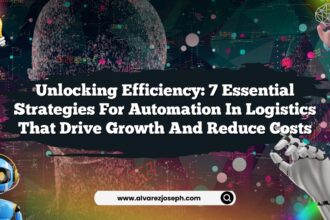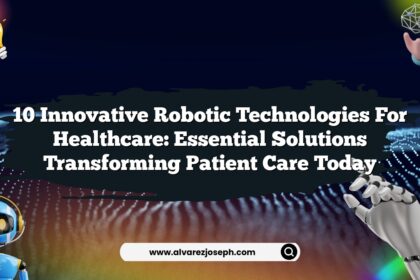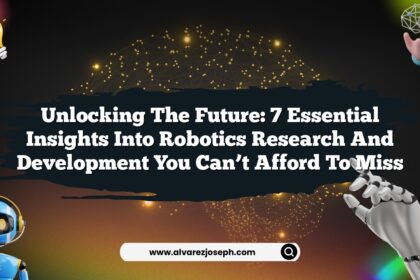Imagine a world where robots not only assist us but also understand our emotions, navigate complex environments, and even collaborate with us in creative endeavors. This isn’t some far-fetched sci-fi fantasy; it’s the rapidly approaching reality of tomorrow’s technology. As we dive into the transformative trends shaping the future of robotics, we’ll explore how advancements in artificial intelligence, automation, and human-robot interaction are redefining what we once thought possible. Buckle up, because the future is not just coming—it’s already here and shaking things up like a toddler with a box of Lego bricks.
The Rise of Collaborative Robots
When we think about robots, images of heavy-duty machinery and factory floors often come to mind. However, the rise of collaborative robots, or cobots, is changing that narrative. These friendly machines are designed not just to work alongside humans, but to enhance our capabilities in unprecedented ways. Unlike traditional robots that operate in isolation, cobots are engineered to understand and respond to human presence, making them perfect partners on assembly lines or in healthcare settings.
Picture this: a hospital where a cobot assists nurses by delivering medications and supplies, allowing them to focus on patient care. It’s a win-win! Not only does this improve efficiency, but it also brings a human touch back to healthcare. As cobots become more sophisticated, they are expected to handle increasingly complex tasks, such as assisting with surgeries or aiding in rehabilitation therapies.
But this isn’t where the story ends. How do these machines learn to interact with us seamlessly? The answer lies in their advanced sensing technologies and machine learning algorithms, which allow them to adapt to their environment and user behaviors. As we explore this topic, let’s keep a close eye on how these developments are impacting industries and reshaping job roles.
Advanced AI: The Brain Behind the Machines
The backbone of this robotic revolution is advanced artificial intelligence. AI is not just about crunching numbers; it’s about making sense of vast amounts of data and learning from it. Imagine if your toaster could predict how you like your toast based on past breakfasts—AI is making that level of personalization a reality for robots.
With deep learning and neural networks, robots can now analyze patterns and enhance their decision-making processes. They can understand context, make predictions, and even generate creative solutions to problems. For instance, autonomous vehicles rely heavily on AI to process real-time data from their surroundings, making split-second decisions that could mean the difference between safety and disaster.
And here’s where it gets even more interesting: as machines become smarter, they start to exhibit forms of creativity that we once thought were uniquely human. Whether it’s composing music or designing artwork, AI is pushing the boundaries of what machines can do. Imagine walking into a gallery filled with paintings created by robots—artistry and technology merging in ways that challenge our perceptions of creativity.
But hold on—does this mean that robots will take over all creative jobs? This concern is valid, but it’s crucial to consider how AI can complement human creativity rather than replace it. The real magic happens when we collaborate with AI, using it as a tool to enhance our own creative processes. The future may hold an exciting partnership between humans and robots, working together to produce incredible works of art.
Robotics and the Internet of Things (IoT): A Connected Future
The Internet of Things (IoT) has transformed how we connect with devices. Now, imagine a world where robots are not only connected to the internet but also communicate with each other. This interconnectedness leads to smarter, more responsive systems that can adapt to real-time conditions.
Consider a smart home filled with IoT devices. A robot vacuum can communicate with your thermostat to optimize energy use while cleaning. Or think about logistics—robots in warehouses can coordinate with each other to manage inventory efficiently, reducing waste and increasing productivity.
Furthermore, IoT allows robots to gather and share data, leading to a feedback loop that continuously improves their performance. This seamless flow of information creates a network of intelligent devices, enhancing our ability to manage resources and respond to changing needs.
But wait—what does this mean for privacy and security? With all these devices connected, concerns about data security are paramount. As we embrace the IoT revolution, we must also be vigilant about protecting sensitive information and ensuring that our smart devices don’t become vulnerabilities.
Human-Robot Interaction: Building Emotional Connections
Okay, picture this: a robot that not only performs tasks but also engages with you on an emotional level. The field of human-robot interaction (HRI) is rapidly evolving, exploring how robots can understand and respond to human emotions. This goes beyond mere functionality; it’s about creating robots that can truly connect with us.
Imagine having a robotic companion that can sense when you’re feeling down and offer comforting words or even a virtual hug. By using sensors and advanced AI, robots can interpret facial expressions, voice tones, and body language, allowing them to respond in ways that feel natural and supportive.
This emotional intelligence opens doors to various applications, from therapy robots assisting those with mental health challenges to educational robots that engage children in learning. The potential here is vast, but it also raises ethical questions. How do we ensure that these machines are programmed to respect human emotions and not manipulate them? As we navigate this terrain, it’s essential to consider the moral implications of our creations.
But here’s a thought—what if robots could teach us something about our own emotions? By interacting with AI that mirrors our feelings, we might gain deeper insights into our emotional landscapes. This could lead to a better understanding of mental health and well-being, enhancing our relationships with ourselves and others.
Sustainable Robotics: Greener Solutions for a Better Tomorrow
With climate change looming over us like that annoying cloud that just won’t go away, the push for sustainable robotics is gaining momentum. Robots are stepping up to tackle environmental challenges, from reducing waste in manufacturing to aiding in precision agriculture.
For instance, agricultural robots can analyze soil conditions and optimize irrigation, leading to higher yields with less water. In urban settings, autonomous drones are being used to monitor air quality and detect pollution levels. This data can inform policies and actions that contribute to a healthier planet.
Moreover, as the world embraces renewable energy, robots are playing a critical role in managing and maintaining solar panels and wind turbines. By automating these processes, we can maximize efficiency and minimize human error, paving the way for a sustainable future.
Now, let’s not forget about the materials used in robotics. Eco-friendly materials are becoming a priority in design and production, pushing the boundaries of innovation. Imagine robots made from biodegradable materials that break down at the end of their life cycle. This shift could significantly reduce the environmental impact of robotics.
But this raises the question: can we truly achieve sustainability in robotics, or is it just a buzzword? While challenges remain, the commitment to exploring greener solutions is a promising step towards a more sustainable future.
Quick Summary
- Collaborative Robots (cobots) enhance productivity by working alongside humans in various fields.
- Advanced AI drives innovation, allowing robots to learn, analyze, and even create.
- The Internet of Things (IoT) connects robots and devices, optimizing processes and improving efficiency.
- Human-Robot Interaction (HRI) explores emotional connections between humans and robots, enhancing their roles in society.
- Sustainable Robotics focuses on eco-friendly practices and technologies, addressing environmental challenges.
- Robotics continues to evolve, shaping industries and redefining our relationships with technology.
- The integration of AI and robotics opens new avenues for creativity and problem-solving.
- Ethical considerations must guide the development of emotionally intelligent robots.
- The interconnectedness of devices enhances operational efficiency while raising security concerns.
- The future of robotics is bright, but its success hinges on our collaboration with technology.
Frequently Asked Questions
What are collaborative robots (cobots)?
Collaborative robots, or cobots, are designed to work alongside humans, enhancing productivity and safety in various tasks.
How does AI improve robot functionality?
AI allows robots to learn from data, make informed decisions, and adapt to complex environments, enhancing their overall functionality and performance.
What role does IoT play in robotics?
The Internet of Things connects robots and devices, enabling them to communicate and share data, leading to smarter and more efficient systems.
Can robots understand human emotions?
Yes, advancements in human-robot interaction allow robots to interpret and respond to human emotions, creating more meaningful connections.
How are robots contributing to sustainability?
Robots are used in agriculture, manufacturing, and energy sectors to optimize resource use and minimize waste, contributing to sustainable practices.
What ethical considerations are there in robotics?
As robots become more integrated into society, ethical concerns around emotional manipulation, data security, and job displacement must be addressed to ensure responsible development.
Ultimately, the future of robotics will depend on how we navigate these complex landscapes. And remember, the journey is just as important as the destination. What are you most excited about in the evolving world of robotics?












